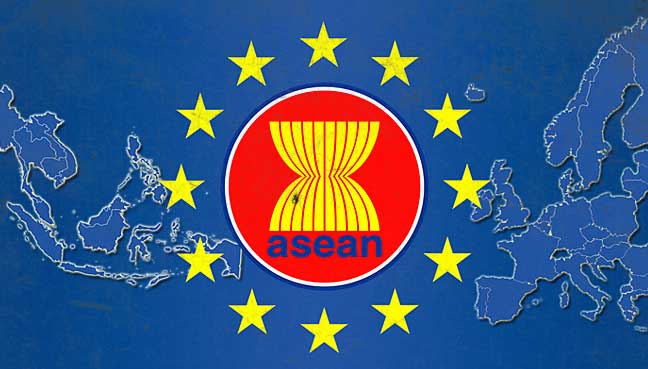In 2019, the EU ranked as ASEAN’s third-largest trading partner, following China and the United States, with a total trade volume of US$ 280.6 billion, constituting 10% of ASEAN’s total trade. Since 1998, ASEAN consistently maintained a trade surplus with the EU, peaking at US$ 54.6 billion in 2017. Additionally, the EU stood as the third-largest source of Foreign Direct Investment (FDI) in ASEAN in 2019, with FDI inflows from the EU totaling US$ 16.2 billion, representing 10.1% of ASEAN’s total FDI.
Negotiations for an ASEAN-EU Free Trade Agreement (FTA) commenced in July 2007. However, after seven rounds of negotiations, both sides agreed to suspend talks in March 2009. At the 15th AEM-EU Trade Commissioner Consultations on March 10, 2017, the AEM and EU Trade Commissioner resolved to initiate formal region-to-region discussions to establish a framework outlining the parameters of a future ASEAN-EU FTA. Subsequently, senior economic officials established a Joint Working Group (JWG) tasked with developing the framework and setting milestones for the negotiations. (Association of Southeast Asian Nation, 2024)
Dialogue between the EU and ASEAN spans more than 45 years, signifying a robust commitment to cooperation and partnership. Their elevation to Strategic Partners on December 1, 2020, marked a significant milestone, underlining a shared vision for regional and global stability. Looking ahead to 2021-2027, the EU has allocated €180 million for regional cooperation with ASEAN, focusing on key areas aligned with the partnership’s goals. Additionally, the EU’s pledge of €10 billion for ASEAN connectivity projects under the Global Gateway initiative highlights its commitment to regional development. The EU-ASEAN 45th Commemorative Summit provided a platform to reaffirm commitments and explore new avenues of collaboration. This partnership, rooted in shared values and mutual respect, remains pivotal for promoting peace, prosperity, and sustainable development in both regions. (EEAS Press Team, 2024)

Overview of ASEAN-European Union Dialogue Relations
1. The EU became ASEAN’s Dialogue Partner in 1977, formalizing ties with the ASEAN-EEC Cooperation Agreement in 1980. The Nuremberg Declaration in 2007 and the Bandar Seri Begawan Plan of Action (2013-2017) marked key milestones, emphasizing cooperation across political/security, economic/trade, and sociocultural domains.
2. The ASEAN-EU Plan of Action (2018-2022), adopted in 2017, prioritizes climate change cooperation. The 40th anniversary of ASEAN-EU Dialogue Relations was commemorated in 2017 with the ASEAN-EU Commemorative Summit.
Political-Security Cooperation
3. The EU actively engages in political-security forums like the ASEAN Regional Forum (ARF) and Post Ministerial Conferences, alongside mechanisms such as the ASEAN-EU Ministerial Meeting (AEMM). The EU’s accession to the Treaty of Amity and Cooperation in Southeast Asia (TAC) in 2012 demonstrated its commitment to regional stability.
4. Discussions at the 22nd ASEAN-EU Ministerial Meeting in 2019 in Brussels explored upgrading EU-ASEAN relations to a Strategic Partnership.
Economic Cooperation
5. The EU is a significant trading partner of ASEAN, with two-way trade totaling USD 282.0 billion in 2018. Negotiations for a bilateral Free Trade Agreement (FTA) are ongoing.
6. Negotiations for an ASEAN-EU Comprehensive Air Transport Agreement (CATA) aim to enhance connectivity.
Socio-Cultural Cooperation
7. The EU supports ASEAN’s efforts in gender equality, migrant worker protection, and education through various initiatives.
8. High-level dialogues on Sustainable Development, Environment, and Climate Change serve as platforms for cooperation on shared challenges.
Development Cooperation Programmes
9. The EU supports ASEAN’s regional integration and connectivity efforts through various programs across all ASEAN pillars, including SUPA, BCAMP, E-READI, and ARISE Plus.
10. Over the years, the EU has funded various programs/projects focusing on capacity building, migration management, statistical capacity building, intellectual property rights protection, and air transport integration.
In summary, ASEAN-EU Dialogue Relations are comprehensive, spanning political-security, economic, socio-cultural, and development cooperation domains, aiming at fostering peace, stability, and prosperity in both regions. (ASEAN Secretariat’s Information Paper, 2019)
References
ASEAN Secretariat’s Information Paper. (2019). OVERVIEW ASEAN-EUROPEAN UNION DIALOGUE RELATIONS 1. The European Union (EU) became ASEAN’s Dialogue Partner in 1977 and it was. ASEAN.org. Retrieved May 7, 2024, from https://asean.org/asean2020/wp-content/uploads/2021/01/Overview-of-ASEAN-EU-Relations-as-of-August-2019.pdf
Association of Southeast Asian Nation. (2024). ASEAN-EU Economic Relation. ASEAN.org. Retrieved May 7, 2024, from https://asean.org/our-communities/economic-community/integration-with-global-economy/asean-eu-economic-relation/
EEAS Press Team. (2024). EU-ASEAN Relations | EEAS. EEAS. Retrieved May 7, 2024, from https://www.eeas.europa.eu/eeas/eu-asean-relations_en
